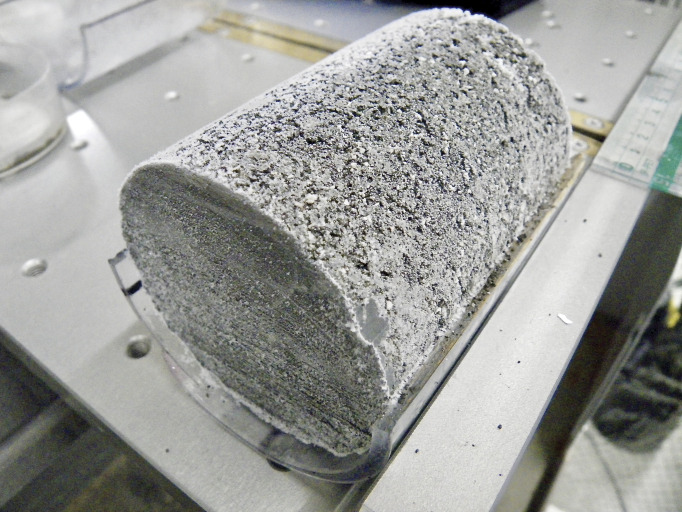Multidecadal Atlantic sea surface temperature variability
Ice covers South Sawtooth Lake on Ellesmere Island.
Surface temperatures in the North Atlantic Ocean have undergone large-scale oscillations, known as the Atlantic multidecadal variability (AMV), during the approximately 160-year instrumental record. This variability has climatic links to regions far beyond the North Atlantic, but its nature over periods longer than the instrumental record is poorly understood. Francois Lapointe et al. (pp. 27171–27178) observed a significant negative correlation between the instrumental AMV and titanium (Ti) levels in an annually laminated lake sediment core from South Sawtooth Lake (SSL), Ellesmere Island, Canada. Levels of Ti were also negatively correlated with Arctic air pressure and North Atlantic sea surface temperature anomalies, which are themselves correlated with AMV, suggesting that the sediment Ti record is a reliable proxy for AMV. The authors used the correlation between the AMV and the SSL Ti record to reconstruct the AMV over the past 2,900 years with annual resolution. The authors’ reconstruction agreed with paleoceanographic proxy records of sea surface temperatures from across the North Atlantic. The record indicates that the warmest interval in the past 2,900 years occurred within the past decade, according to the authors. — B.D.
Ferromagnetism and antiferromagnetism coexist in crystal
Ferromagnetic and antiferromagnetic order appearing in pyrochlore Yb2Ti2O7. Image credit: Jill Hemman (Oak Ridge National Laboratory, Oak Ridge, TN).
Quantum materials defy classical theories on how atomic bonds and interactions among electrons determine characteristic material properties. Allen Scheie et al. (pp. 27245–27254) examined the exotic properties of a quantum material called Yb2Ti2O7, a pyrochlore crystal exhibiting low-temperature quantum magnetic properties that are poorly understood. Using elastic neutron scattering, the authors found that the ground-state magnetic properties of Yb2Ti2O7 arise from a stable, long-range canted ferromagnetic structure. Next, the authors used inelastic neutron scattering and computer modeling to reveal the existence of a second, embedded state: a medium-scale, metastable antiferromagnetic structure that, at low temperatures, lies within the ferromagnetic ground state. This finding indicates that two seemingly disparate forms of magnetism—ferromagnetism and antiferromagnetism—exist simultaneously in Yb2Ti2O7. According to the authors, the unusual properties of Yb2Ti2O7 likely stem from a type of phase coexistence, in which antiferromagnetism appears within an otherwise ferromagnetic phase. — T.J.
Global analysis of microbial diversity in marine sediment
A piece of the frozen marine sediment core sample.
Marine sediment covers 70% of the Earth’s surface, but little is known about the global patterns of microbial diversity in marine sediment. Tatsuhiko Hoshino et al. (pp. 27587–27597) analyzed 299 samples of marine sediment collected as core samples from 40 sites around the globe during 14 expeditions. The sample depths ranged from the seafloor to 678 meters below the seafloor. To accurately determine the diversity of microbial communities, the authors extracted and sequenced DNA from each frozen sample under the same laboratory conditions. The authors found that the diversity of microorganisms in marine sediment generally decreased with depth. The authors also found that the concentrations of organic carbon and presence of dissolved oxygen are key determinants of the taxonomic composition of sedimentary communities. Comparing the microbial diversity with that of topsoil and seawater revealed that each of the three biomes has different microbial communities but similar overall diversity. According to the authors, analysis of the biomes suggests that bacteria are more diverse than Archaea in the global biosphere. — T.H.D.
Probiotic bacteria and multiple sclerosis severity
Multiple sclerosis is an autoimmune disease and a leading cause of nontraumatic neurological disability in young adults. Recent evidence suggests that the gut microbiome modulates disease risk, but the specific bacterial species and the role of host genetics have not been clear. Theresa Montgomery, Axel Künstner, et al. (pp. 27516–27527) modulated the gut microbiome of genetically diverse mice with experimental autoimmune encephalomyelitis (EAE), an animal model for multiple sclerosis. Wild-derived PWD strain of mice and conventional laboratory B6 mice had different levels of susceptibility to EAE and different gut microbiome profiles. Transplantation of gut microbes from PWD mice to B6 mice resulted in more severe EAE compared with transplantation between B6 mice. Additional analysis revealed that Lactobacillus reuteri, a commensal species commonly found in the gut and often used in probiotics, was almost completely absent in B6 mice but highly abundant in PWD mice. Moreover, B6 mice that were colonized with L. reuteri isolated from PWD mice developed more severe EAE, compared with control B6 mice lacking this bacterial species. According to the authors, antibiotic or probiotic strategies to prevent or treat multiple sclerosis should take into account host genetics and the preexisting gut microbiome. — J.W.
Plague outbreaks during the second pandemic
Plague outbreaks during the second pandemic spanning the 14th to 17th centuries decimated human populations in Europe and Asia. Although genetic studies of the causative pathogen, Yersinia pestis, have yielded important insights, several aspects of the disease transmission mode and dynamics remain unclear. David Earn et al. (pp. 27703–27711) analyzed historical, demographic, and epidemiological data from London, England, and estimated mortality using three datasets assembled between 1348 and 1666. The archival records included the London Bills of Mortality, parish registers, and wills and testaments. The data revealed that the epidemic growth rate increased by a factor of four from the Black Death of 1348 to later epidemics, ending with the Great Plague of 1665. Additional analyses of mortality rates suggest that the 14th-century epidemics, and possibly later epidemics, likely did not spread primarily through direct, or pneumonic, human-to-human transmission. Instead, the growth rates for both the early and late epidemics are consistent with bubonic, or indirect, flea-driven, transmission. In addition, climatic changes such as cooling temperatures and the substantial increase in human population density during the 300-year period may have contributed to the increase in the plague epidemic growth rate, according to the authors. — J.W.
Great Chinese Famine and tuberculosis risk
Chinese agricultural production collapsed during the Great Leap Forward, leading to one of the largest famines in human history, spanning 1958 to 1962.
The Great Chinese Famine, which spanned 1958 to 1962, was among the deadliest famines in human history. Yet the famine’s long-term impact on infectious diseases remains uncertain. To assess the impact of the famine on pulmonary tuberculosis (PTB) over subsequent decades, Qu Cheng et al. (pp. 27549–27555) analyzed data from more than one million PTB cases reported between 2005 and 2018 in Sichuan Province, which experienced high mortality rates during the famine. The authors also used a model that accounted for risks associated with aging as well as trends in tuberculosis incidence over time. When compared with neighboring cohorts, people born during the famine and their putative children exhibited significantly higher rates of tuberculosis, suggesting an intergenerational effect of prenatal and early life exposure to famine. A comparison of cohorts that were and were not affected by the famine found that more than 12,000 active PTB cases reported between 2005 and 2018 in Sichuan province were attributable to the famine. The findings suggest that individuals who experience severe malnourishment early in life, as well as their children, are at a heightened risk of contracting PTB in adulthood, according to the authors. — M.S.






